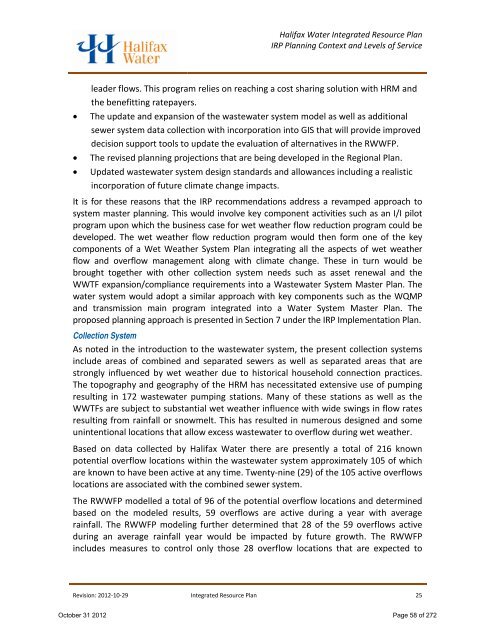volume 1 - Halifax Regional Municipality
volume 1 - Halifax Regional Municipality
volume 1 - Halifax Regional Municipality
You also want an ePaper? Increase the reach of your titles
YUMPU automatically turns print PDFs into web optimized ePapers that Google loves.
<strong>Halifax</strong> Water Integrated Resource Plan<br />
IRP Planning Context and Levels of Service<br />
leader flows. This program relies on reaching a cost sharing solution with HRM and<br />
the benefitting ratepayers.<br />
• The update and expansion of the wastewater system model as well as additional<br />
sewer system data collection with incorporation into GIS that will provide improved<br />
decision support tools to update the evaluation of alternatives in the RWWFP.<br />
• The revised planning projections that are being developed in the <strong>Regional</strong> Plan.<br />
• Updated wastewater system design standards and allowances including a realistic<br />
incorporation of future climate change impacts.<br />
It is for these reasons that the IRP recommendations address a revamped approach to<br />
system master planning. This would involve key component activities such as an I/I pilot<br />
program upon which the business case for wet weather flow reduction program could be<br />
developed. The wet weather flow reduction program would then form one of the key<br />
components of a Wet Weather System Plan integrating all the aspects of wet weather<br />
flow and overflow management along with climate change. These in turn would be<br />
brought together with other collection system needs such as asset renewal and the<br />
WWTF expansion/compliance requirements into a Wastewater System Master Plan. The<br />
water system would adopt a similar approach with key components such as the WQMP<br />
and transmission main program integrated into a Water System Master Plan. The<br />
proposed planning approach is presented in Section 7 under the IRP Implementation Plan.<br />
Collection System<br />
As noted in the introduction to the wastewater system, the present collection systems<br />
include areas of combined and separated sewers as well as separated areas that are<br />
strongly influenced by wet weather due to historical household connection practices.<br />
The topography and geography of the HRM has necessitated extensive use of pumping<br />
resulting in 172 wastewater pumping stations. Many of these stations as well as the<br />
WWTFs are subject to substantial wet weather influence with wide swings in flow rates<br />
resulting from rainfall or snowmelt. This has resulted in numerous designed and some<br />
unintentional locations that allow excess wastewater to overflow during wet weather.<br />
Based on data collected by <strong>Halifax</strong> Water there are presently a total of 216 known<br />
potential overflow locations within the wastewater system approximately 105 of which<br />
are known to have been active at any time. Twenty-nine (29) of the 105 active overflows<br />
locations are associated with the combined sewer system.<br />
The RWWFP modelled a total of 96 of the potential overflow locations and determined<br />
based on the modeled results, 59 overflows are active during a year with average<br />
rainfall. The RWWFP modeling further determined that 28 of the 59 overflows active<br />
during an average rainfall year would be impacted by future growth. The RWWFP<br />
includes measures to control only those 28 overflow locations that are expected to<br />
Revision: 2012-10-29 Integrated Resource Plan 25<br />
October 31 2012 Page 58 of 272
















